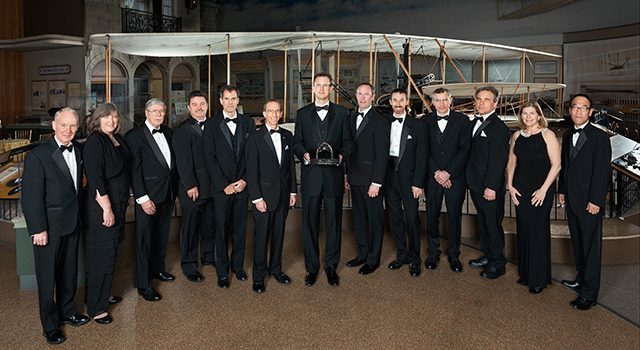Mar 31 2014
The team in charge of NASA's Dawn mission, history's first detailed exploration of a celestial body inside the main asteroid belt, received the Smithsonian National Air and Space Museum's highest group honor at a dinner in Washington on March 26. Dawn, managed by NASA's Jet Propulsion Laboratory, Pasadena, Calif., received the 2014 Trophy for Current Achievement, which honors outstanding achievements in the fields of aerospace science and technology.
 The flight team for NASA's Dawn mission received the 2014 Trophy for Current Achievement from the Smithsonian National Air and Space Museum on March 26, 2014. Pictured here are the following members of the team (from left to right): Grant Faris, Carol Polanskey, Chris Russell, Steve Joy, Greg Whiffen, Marc Rayman, Robert Mase, Tim Weise, Brett Smith, Nick Mastrodemos, Paul Fieseler, Carol Raymond and Don Han. Image credit: Smithsonian National Air and Space Museum
The flight team for NASA's Dawn mission received the 2014 Trophy for Current Achievement from the Smithsonian National Air and Space Museum on March 26, 2014. Pictured here are the following members of the team (from left to right): Grant Faris, Carol Polanskey, Chris Russell, Steve Joy, Greg Whiffen, Marc Rayman, Robert Mase, Tim Weise, Brett Smith, Nick Mastrodemos, Paul Fieseler, Carol Raymond and Don Han. Image credit: Smithsonian National Air and Space Museum
Having explored the giant asteroid Vesta and on its way to the dwarf planet Ceres, the Dawn spacecraft is designed to conduct an in-depth and up-close study of these two celestial bodies formed early in the history of the solar system. In 50 years of space exploration, no other spacecraft has orbited a distant solar system body, then left to travel to-and eventually orbit-another extraterrestrial body.
The California Institute of Technology in Pasadena, manages JPL for NASA's Science Mission Directorate, Washington. UCLA is responsible for overall Dawn mission science. Orbital Sciences Corp. in Dulles, Va., designed and built the spacecraft.
Several NASA planetary mission teams have won the award in previous years, including last year, when NASA's Curiosity rover, also managed by JPL, picked up the trophy. The year before that, NASA's Cassini mission to Saturn, also managed by JPL, took the honor. For a full listing of previous awardees, along with a video about Dawn's award, visit: http://airandspace.si.edu/events/trophy/
For more information about Dawn, visit: http://www.nasa.gov/dawn and http://dawn.jpl.nasa.gov